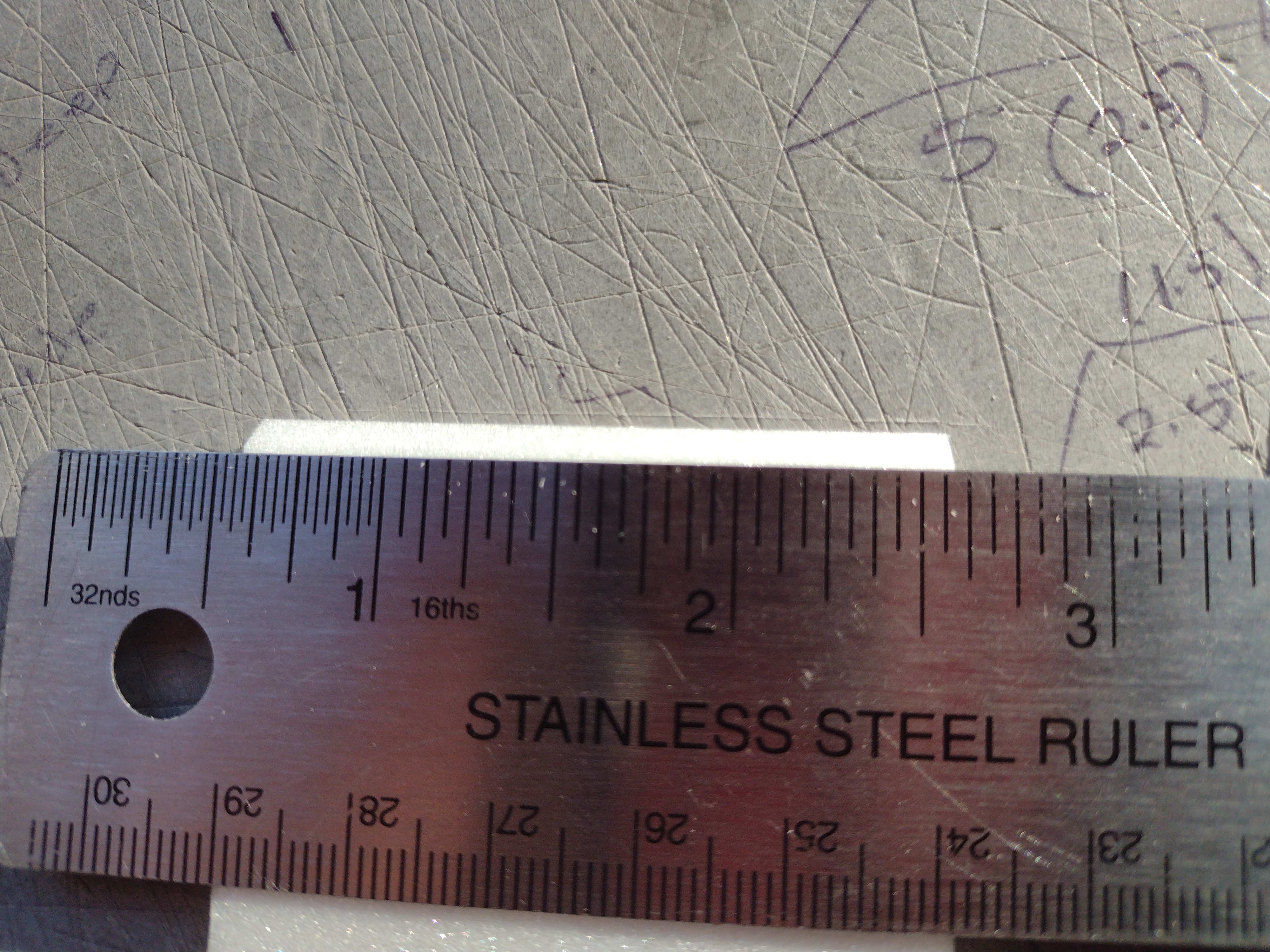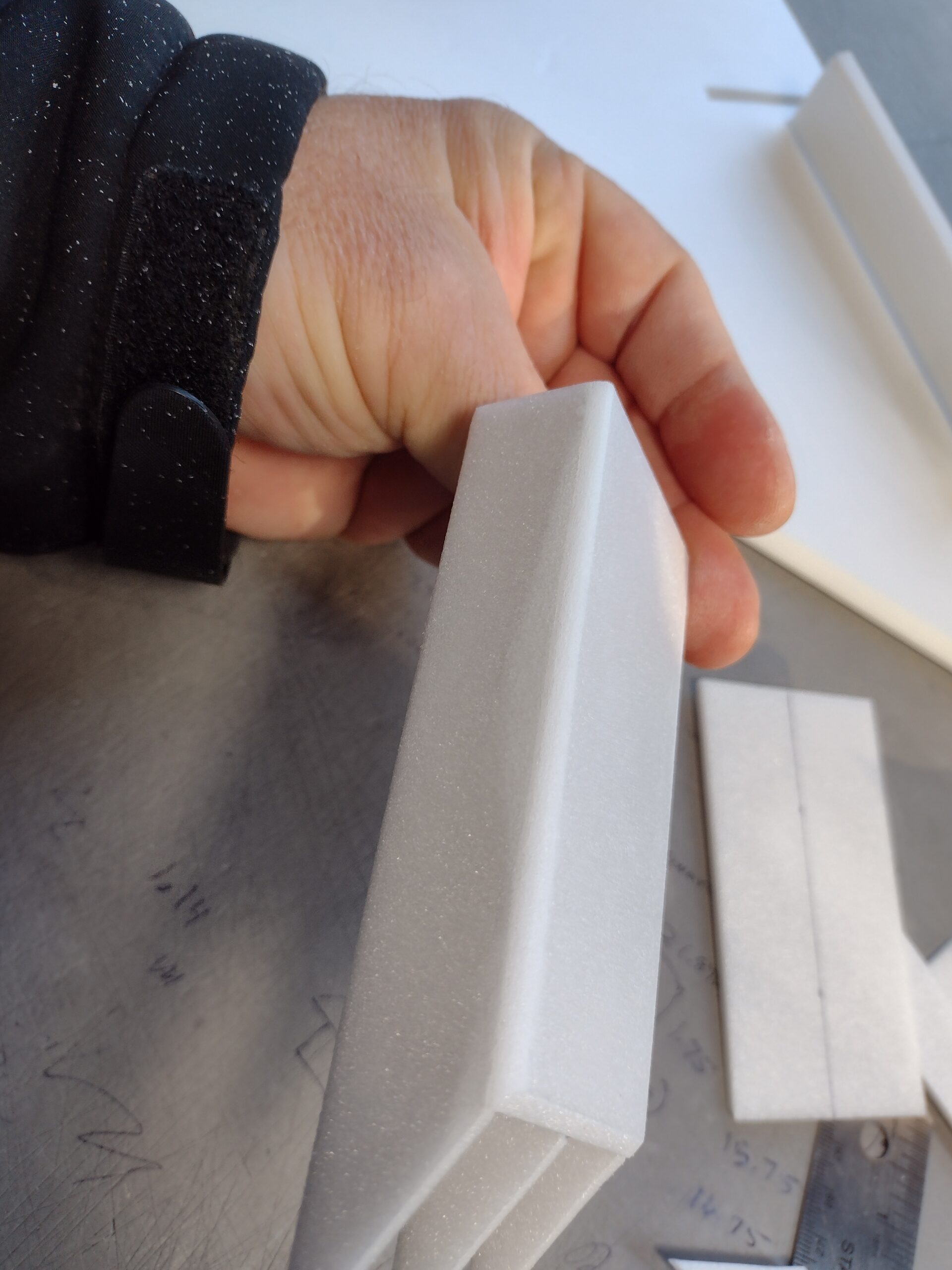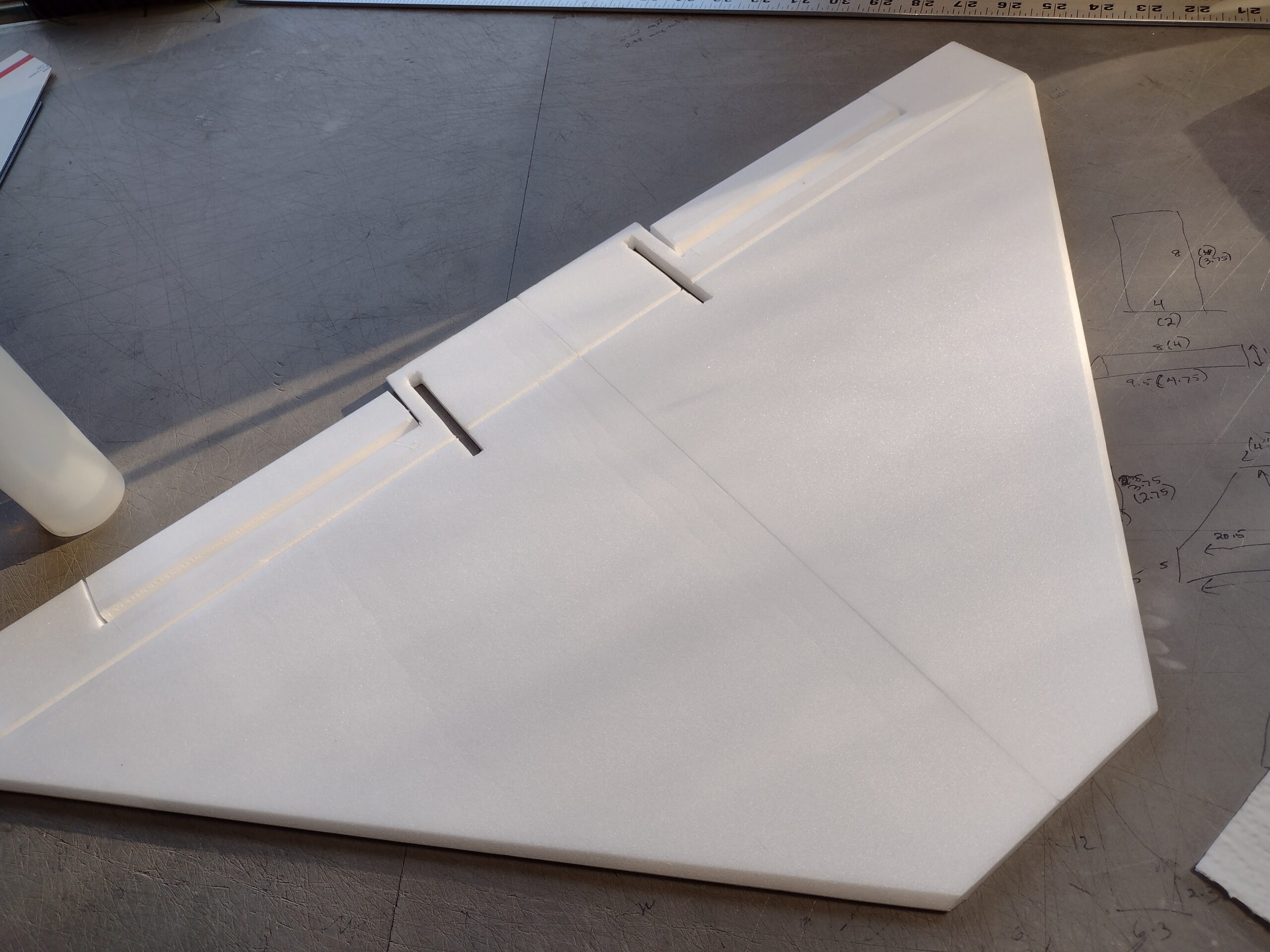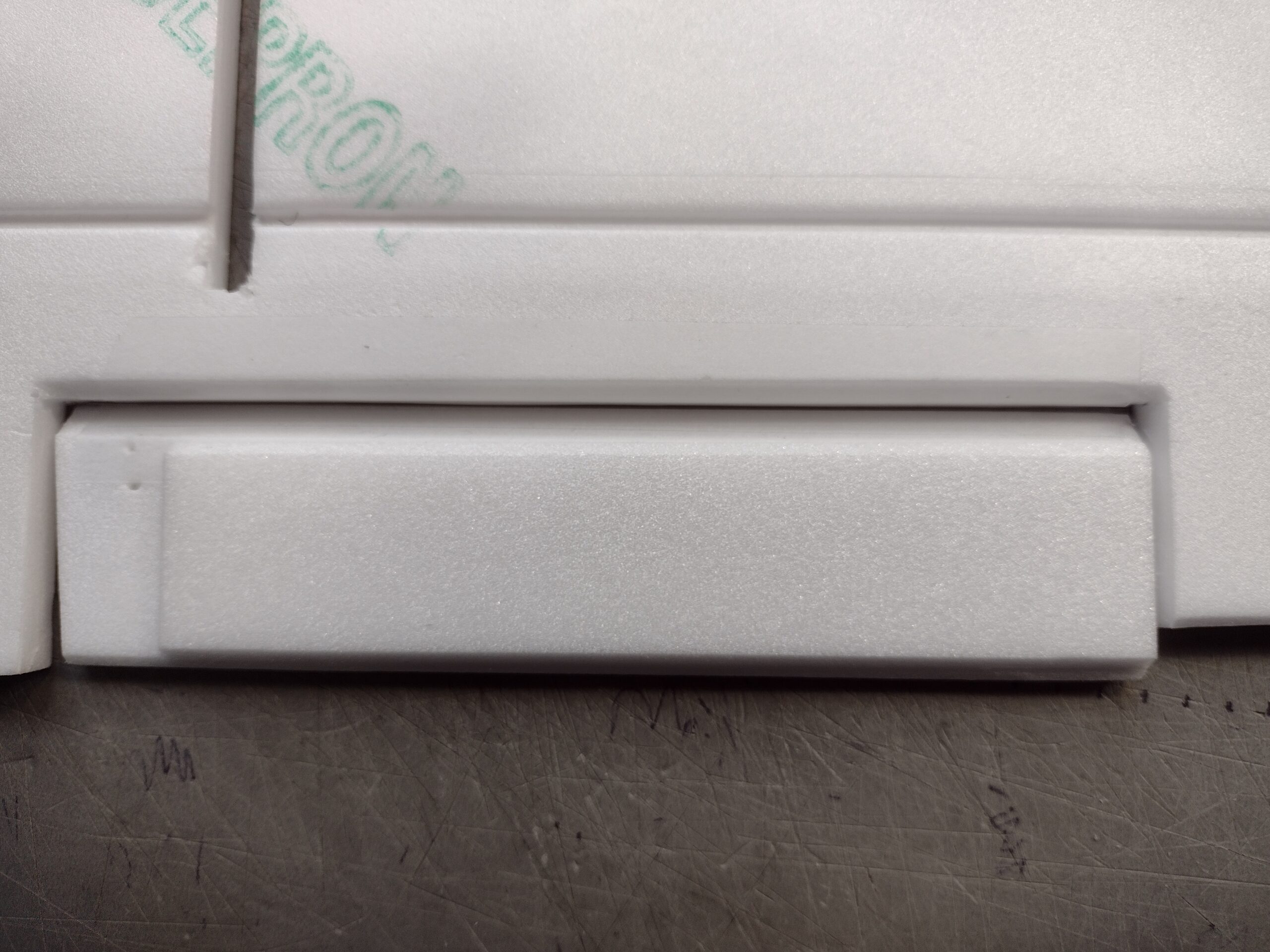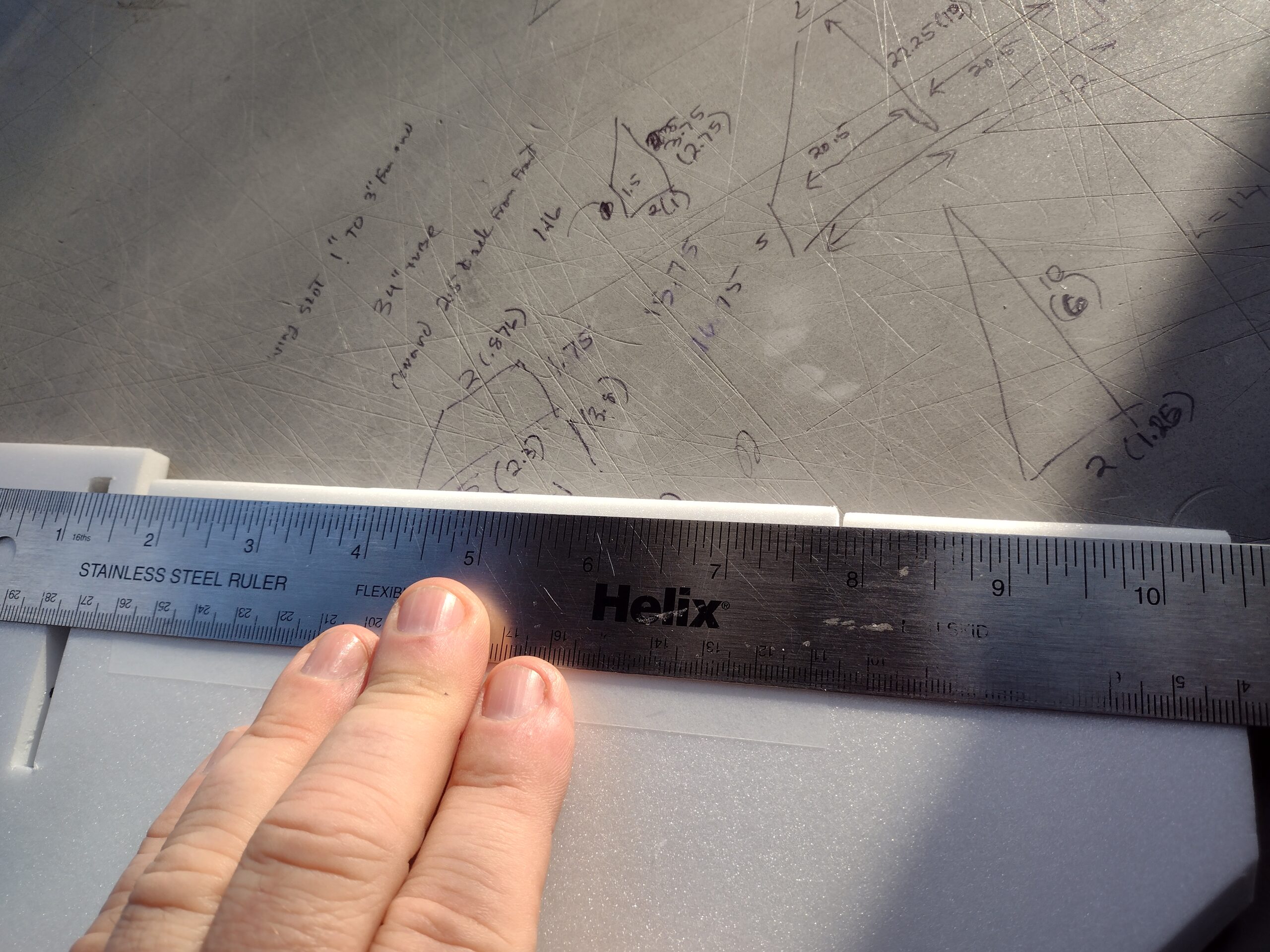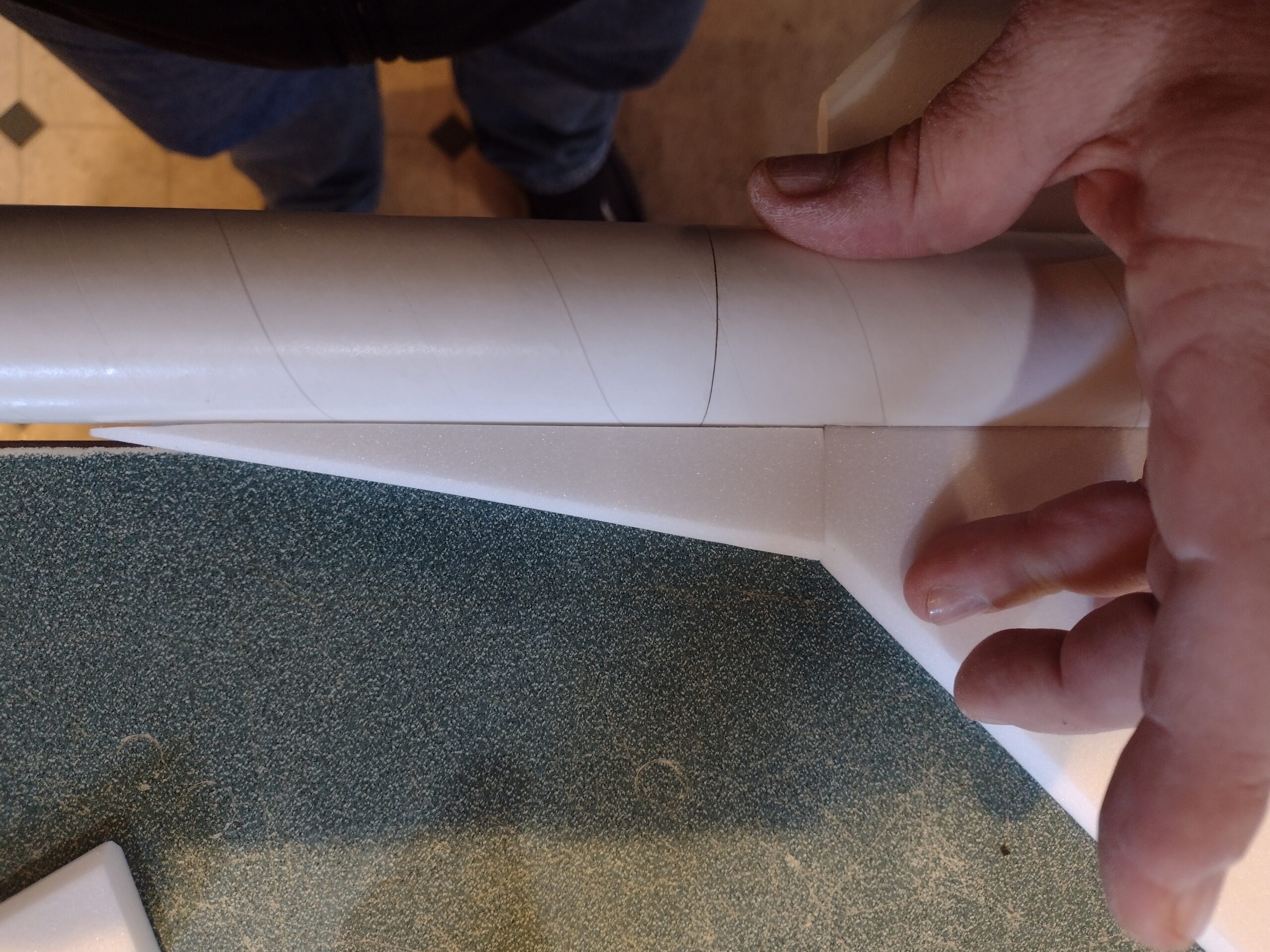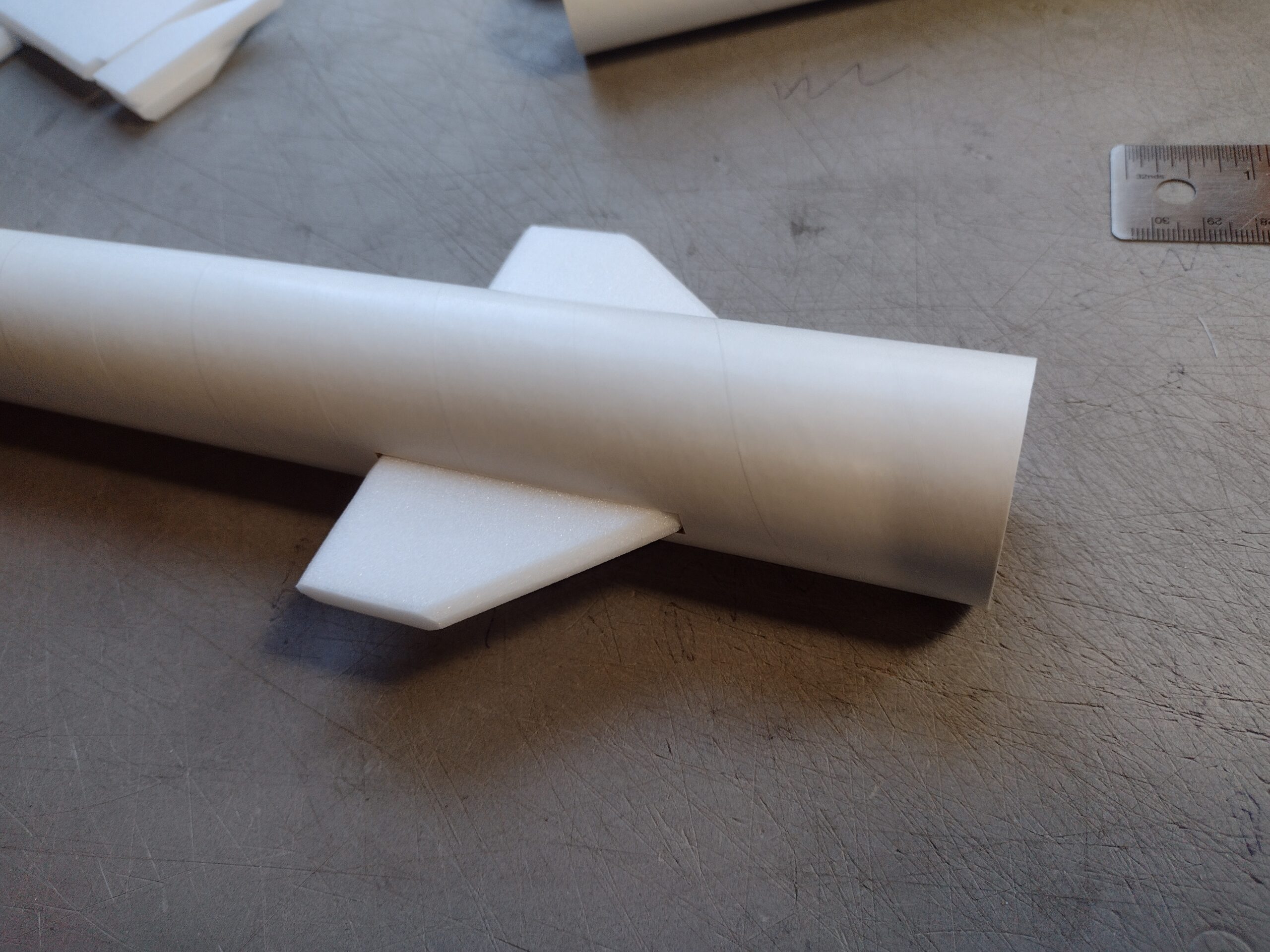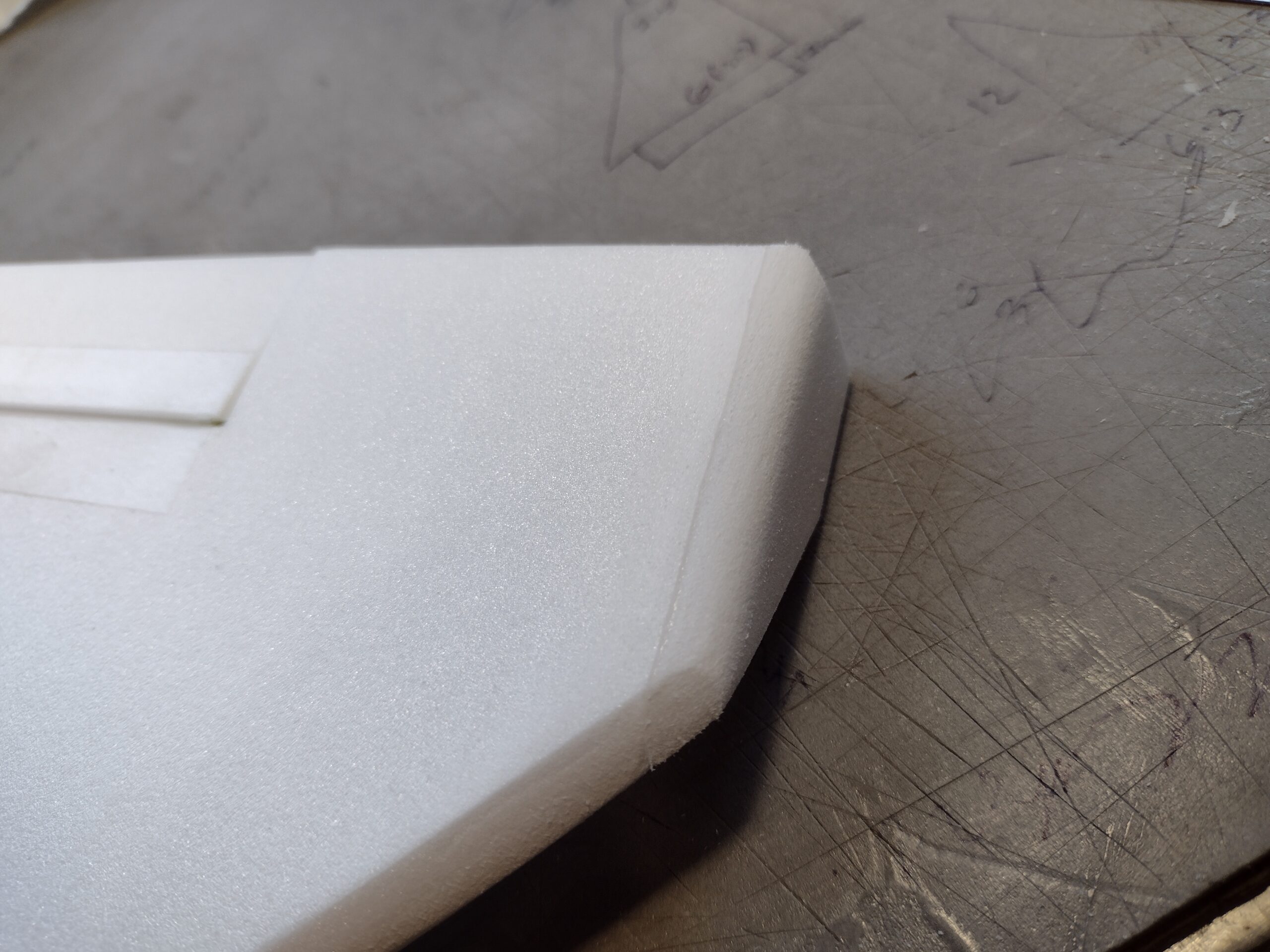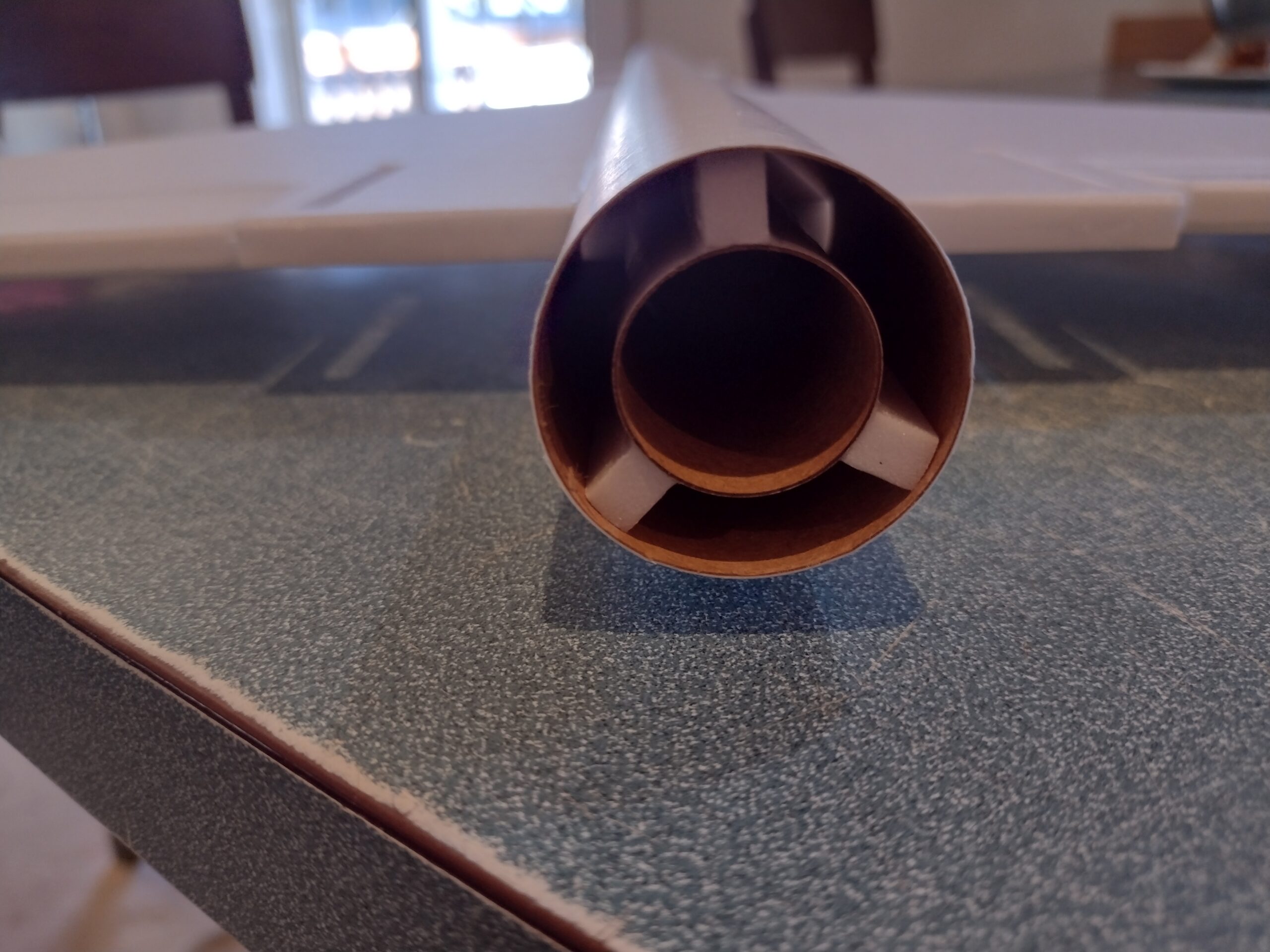
The Super Sonic Transport RC Rocketplane kit is a sleek design loosely based on the Estes Orbital Transport Booster but redesigned to boost and glide with R/C Control. It comes with BT-60 white tubing for the body 9mm depron wing and 6mm tail and canard surfaces. The body tube is pre-slotted for the tail and canard and rail button holes are pre-punched. Elevons are pre-hinged. Construction and radio install is slightly more complicated than my other kits. Length 38.5″ long, 24″ wingspan, 1.65″ diameter, 8.8-9.5 oz ready to fly for reloadable 24mm Aerotech composite E-6RC motors only. Please refer to the General information for all kits tab above, then read these instructions completely before starting assembly. Excellent high quality cut vinyl decals are available separately from stickershock.com HERE ** You need to decide if you want decals for the SST only, SST Plus BT-50 Orbiter or SST Plus BT-20 Orbiter.**
CG location for rocket flight: 8.75″ forward from the trailing edge of the wing with loaded motor and battery ready for flight.
Welcome to the world of rocketplanes. This is not a model for a novice RC pilot, but anyone who is comfortable with RC flying of a medium speed aileron controlled model should be fine. Read through the instructions, look at the photos and be sure you understand the step before commiting to cutting or glue.
Identify all pieces, the kit should contain:
1 wing taped together 9mm depron
2 pushrods and 2 control horns
2 3mm depron intake bottom plates 2″ by 4″
2 3mm depron elevon covers 1.25″ by 5 3/8″
6 intake 3mm side plates
2 vertical stabilizers 6mm depron
1 canard 6mm depron
2 chines(triangular pieces) 9mm depron
2 Body Tubes(rear with a long slot for the wing and rail button holes, front with a short slot for the canard)
1 coupler, may be placed inside the body tube for shipping
1 23″ spar
1 roll blenderm tape
24mm Motor mount
3 1/4″ x 2.75″ strips to center the motor tube.
Velcro(for battery attachment)
2 Rail buttons with t nuts/screws
Lead weight
Spare foam (for testing paint, or small repairs)
Notes before starting:
Foam safe CA+(Bob smith super gold + is good) is the only glue recommended for primary construction. You will also need foam safe accellerator to set the glue.
Assembly:
- Use a straight edge and knife to cut a 45 degree bevel in one end of the 2″ by 4″ 3mm intake plates and flip the plate upside down.
- Mark the center of the 2″ by 4″ plate and make a line down the center.
- The 3mm side plates have a short side and a long side, glue the short side of one of the 3mm intake side plates on the center line and one on each side even with the sides of the 2″ by 4″ plate.
- They should be even with the bevel at the front, if you need to trim the rear so they are even with the end that is fine.
- Reinforce the joints with CA and make sure it is set.
- Sand the side joint if needed and round the left and right corners slightly rounded.
- Glue two of the short 18mm tubes to the inside rear of the intake assembly so that 5/8″ of the tube sticks out the back, see photos for details. If you are using the stickershock decals I found it is easier to apply the little triangle wraps around the nozzles before installing them, they also help in determining how much should stick out of the intake assembly.
- Glue the taped wing joint and lay flat to set.
- Test fit, then glue the 2.5mm spar into the pre-cut slot in the bottom of the wing. Make sure the glue is set, then tape over the spar and the center joint with the included blenderm tape.
- Install both rail buttons in the rear tube with the pre-punched holes, the t nut goes on the inside of the tube, then the washer, collar, washer and then screw goes into the t nut.
- Using a thin ruler/straight edge and exacto knife, cut a bevel into one of the long edges of each of the 3mm 1.25″ by 5 3/8″ long plates, these will glue to the bottom of the elevons. The reason this is done is so the control horn can pass all the way through the 6mm elevon and you can put glue on the top of the prongs to lock them in place, if I used 9mm thick foam the prongs wouldn’t go all the way through and the glue joint not as strong.
- Glue each of the plates to the bottom of each elevon, the outboard end of the plate should be even with the outboard end of the elevon and the bevel should line up with the bevel cut for the hinge relief joint. Make sure you don’t cover up the holes for mounting the horns. If extra hangs over the rear of the elevon that will be trimmed in the next step.
- Using a thin ruler/straight edge and exacto knife to cut bevels on top and bottom of both sides of the leading and trailing edges of the wing, leading and trailing edge of the canard, leading and trailing edges of both stabilizers, leading edge(long edge) of the 9mm chines, and leading and trailing edges of ONE SIDE ONLY of the wing tips, make sure to make a left and right wing tip when you cut the bevels. This will help aerodynamically and look much better if you do this.
- Test fit the wing in the slotted tube, trim the slot if needed. The spar will go down and be on the same side as the rail buttons, the rear is 3″ from the end, the front is 1″ from the end, make sure you have the orientation correct, and make sure the wing is centered front and back, then tack glue the front and back with CA and make sure it is set. Then apply a fillet on the top and bottom of the body tube/wing joint, you may need to squeeze slightly on the body tube to make sure it makes contact with the wing until the glue sets.
- Lay some waxed paper over a table edge and then lay one wing right side up on the table on the waxed paper allowing the body tube to hang off the table edge slightly. Put a book or weight on the wing to keep the model from moving. Test fit, sand if needed then glue a chine to the front of the wing and body tube making sure it stays flat with the table top so it keeps it aligned with the wing. Make sure it is set and then apply a fillet on top and bottom of the chine. Repeat for the other side.
- The forward body tube has a short slot 2″ from the front. Test fit then glue the canard into the slot making sure it is centered. Apply a fillet top and bottom and make sure it is set.
- Glue the coupler into the rear end of the forward body tube, the end without the canard.
- The rear end of the tube with the coupler has an arrow drawn on it, this aligns with an arrow on the front of the rear body tube with the wing installed. The arrow is drawn when I mark the slots but due to slight variances in cutting, the canard may not line up perfectly with the wing if you just use the arrow mark, the arrow is there for reference but double check before gluing the two tubes together by looking from the front and making sure the wing and canard are aligned. Put some glue into the forward end of the rear body tube then quickly insert the coupler into the rear and make sure things are aligned right, if you want to use a slower setting glue like 5 minute epoxy to give you more working time, that is fine.
- Lay one wing upside down flat on a table letting the body tube hang over the table edge and put some waxed paper underneath. Glue a wingtip in place it should butt against the wing tip and point up since the model is upside down, glue so the bevel you cut on the wingtip is pointing away from the model. When the model is right side up the wing tip will point down. Make sure the glue is set, then using a knife cut a bevel in the wingtip leading edge to match the one on the wing, then sand the corner of the wingtip rounded.
- Using some 2″ wide packing tape apply it to the bottom of the body tube between the rail buttons and all the way to the front. This helps protect the tube from water and dirt on landing.
- Glue in the control horns/pushrods into the bottom of each elevon. There is a right and left, have the pushrod closest to the body tube, they may angle in slightly, this is normal.
- Apply glue to the prongs on the top of the wing to lock the horns in place.
- Measure 11″ from the rear of the body tube and make a mark and another at 13″. You will cut a hatch using these marks for the front and rear of the hatch, the hatch should be 2″ long and 1.25″ wide. Remove and save that piece of body tube. Be careful you don’t cut too deep into the tube and damage the servo wires while cutting. ***Note!!**If you are planning on building a piggyback orbiter you may want to cut the hatch an inch further back so that the mounting of the electronic release can be forward of the hatch and still be balanced, that way the battery and rx is a bit behind the CG and the release and glider is a bit ahead of the CG. It helps strength if the two cutouts aren’t on top of each other. Piggyback Orbiter guidelines are HERE
- Using packing tape make a hinge on one side of the hatch taping both inside and outside of the tube and hatch. Make a small tab on the other side of the hatch by taping packing tape 1″ wide and 1.5″ long to the hatch, folding it over on itself about 1/4″ and then taping to the inside of the hatch. See pictures.
- On my models, I added some little 3″ long by 3/4″ tall foam triangles cut from spare foam that are about a ruler width away from the fuse and glued parallel with the Vertical Stabs, this mimics the little bits on the Orbital Transport booster but they aren’t necessary..
The basic construction is now complete.
Radio Installation
Note: Your radio needs to be configured for Delta or elevon mixing, this means that the servo arms will move the same direction during elevator stick movement and opposite for aileron stick movement. Connect your servos to the receiver one in the aileron connection and one on the elevator connection and apply power. The kit includes an adapter wire to connect a JST battery connector to the receiver. This should plug into the battery or bind position in the receiver. Make sure you bind the receiver to the radio following the radio instructions. Use a servo arm at least 9/16” long and with holes small enough that there won’t be slop with the pushrod wire when installed. I use the hole furthest out on the servo arm, to maximize movement. On some servos there are a long two-ended servo arm, you can trim off one end if needed to get sufficient length. Zero out any trim settings on the transmitter.
- Connect a servo to each pushrod. The servo will be inside of the pushrod closest to the body tube and the servo control wire will face forward toward the front of the model. If the pushrod is too tight, you can use twist an X-Acto knife in the servo arm hole to make it larger, but be careful and do not make it too large. Once connected, tape each servo in place on the bottom of the wing so that the control surfaces are centered. Look at the model from the rear. Moving the transmitter stick back(up elevator) should move both elevons up. Moving the transmitter stick to the right should move the right elevon up and the left elevon down. If you can’t get the servo reversing to give you the right polarity try swapping aileron/elevator inputs to the receiver or turning the servos over and swapping the servo arms to the other side of the output shaft. If that is correct, continue.
- The servos will glue to the bottom of the wing. The Engine intake assembly will cover over the servo but the servo arm and pushrod will be exposed. You will need to trim the intake to fit over the servo arm. The servo will need to be located so that the servo arm lines up just inside the inboard edge of the elevon. See photo. If the servo is not lined up inboard to the elevon edge, you can bend the z bends on each end of the rod to allow it to angle in more to get better alignment.
- With the radio still on, put a moderate amount of glue on the servo, being careful not to get any near the output shaft, and set it in place on the wing as described above, keeping the control surface centered. Do the same to the other side. Make sure the glue is set before continuing.
- Make sure the control surfaces are centered, use trims if needed. Now measure the control surface movement. Full elevator movement should be 1/2 to 5/8” in each direction, aileron movement should be 1/4″ to 3/8″ in each direction.
- If you have a flap/elevator mix you can program elevator trim to a switch setting. I use the long D switch on my dx-8, up is launch and down all the way is glide. The model needs approximately 3/16″ to 1/4″ of up trim for glide. You can also use flight modes to set different launch and glide elevator trim settings and control those via the D switch and using trim settings set to fmode and not common. I also use the fmode audible naming up is “launch mode” and down is “landing mode” so I can hear the switch position and make sure I don’t launch in landing mode with up trim.
- Disconnect the servo wires from the receiver.
- The servo wire will route directly toward the body tube, you will need to cut a 1/8″ by 1/2″ slot in the body tube at the joint where it hits the wing to route the servo plug into the body tube.
- Route the servo wire into the body tube and make sure it goes forward.
- Route the servo wires out of the hole and connect to the receiver.
- Notch one of the intake assemblies to clear the servo arm, servo body if needed and notch the two inboard intake plates to fit over the servo wire. Make sure it won’t interfere with the servo arm movement. Test fit, then when happy glue the intake assembly to the wing so the rear of the foam assembly is even with the rear of the wing, the exhaust nozzles will stick back further. Make sure the intake doesn’t interfere with the elevon movement.
- Repeat for the other side.
- Place your receiver inside the hatch pushing it as far to the rear as possible, and pushing the servo wires back along with it. On mine there was just enough space, if there is not you can cut a small pocket into the wing foam inside the hatch toward the rear and fit the receiver into that recess.
- Use velcro to secure the battery toward the front of the hatch, you can slide the battery forward under the front of the hatch if needed.
- After plugging the battery in, I use a small piece of masking tape to hold the tab on the latch against the body tube to keep it from opening in flight.
- Test fit, then glue the two stabilizers into the slots in the wing. If the stabilizers don’t point straight up, you can trim the slot slightly with an exacto, they can angle in or out slightly, it won’t affect performance. Put a fillet on each side of the stabilizers. You may need to cut a small notch in the tab on the stabilizer to clear the carbon spar if needed.
- Glue one of the 1/4″ by 2.75″ long motor centering strips onto the middle mark on the pre-marked motor tube. The other two strips will glue below the other two marks on the tube on the left and right, about the width of the centering strip below the mark, if you look from the front of the tube they will make a Y shape.
- Test fit the motor mount into the rear of the model. The tabs are oversized for fitting. Sand each tab a bit at a time till it will insert snugly into the rear of the body tube. The motor tabs will look like an upside down “Y” so that the tabs will clear the rail button in the rear of the tube. Slide the mount in so it is flush with the rear of the body tube, then run glue from the rear down each tab holding the model pointing down so the glue will run down each side of each centering strip to glue the mount in place. Make sure the glue is set.
- The final assembly is complete except for markings and balancing. Apply the markings before balancing.
- If you use the stickershock markings, once you apply the markings, use a hair dryer on hot to warm the markings and them push them down into the foam surface with your finger. The will really conform and stick down well. The decals include 2″ by 4″ white strips to help protect the bottom of the intakes from landing damage, if you do not use the stickershock decals you may protect them with spare vinyl or packing tape, depending on the type of landing surface you have.
- Insert your battery and heaviest loaded rocket motor into the motor mount
- Support the model at the balance point. I use two chopsticks pointed up and held in place with a small hand vice, and some square pieces of scrap depron pushed into them to protect the wing of the model. Place the model upside down on the balance point indicated at the top of this page in red. Use pieces of the included lead weight as far forward into the tip of the nose to balance it, or in the tail as needed. Glue the lead weight in place so it does not shift during flight. Do not try to fly the model too nose or tail heavy. Remember, a nose heavy model flies poorly, a tail heavy model flies once. You should not need much nose weight, I provide extra, use just enough for correct balance. Do not just use fingers to balance the model, this is not accurate and can lead to a tail heavy model.
- Once balanced, tape or glue the nose cone in place securely.
Flying: See the General Instruction link at the top for flying instructions. Be ready on the first few flights to keep the model straight till you have the trims set perfectly for boost and glide.
- Bevel front of intake plates
- Mark a centerline down the intake plate and glue three side plates in place
- front view showing side plates and bevel on leading edge.
- Sanding the intake assembly side edges round.
- nozzles glued into intake assembly
- Exhaust tube glued into assembly leaving 5/8″ sticking out.
- Glue wing joint.
- Wing joint Glued and lay flat to set.
- Spare glued in place
- Spar and center joint taped over with blenderm tape
- Rail Buttons installed.
- Bevel leading edges of the chines.
- Bevel the 1.25″ by 5 3/8″ 3mm sheets on one edge at a 45 degree angle with a straight edge and exacto.
- Glue one of the 3mm sheets to the bottom of each elevon, the outboard end should be flush with the elevon and the bevel should be aligned with the bevel cut for the hinge, this leaves a spot for the control horn to glue into the pre-made holes, do not cover up these holes!
- Beveling trailing edges of wing using straight edge and exacto knife.
- Wing leading edge beveled top and bottom
- Stabilizer leading and trailing edges beveled.
- Canard Leading and trailing edges beveled.
- Wing tip leading and trailing edges beveled on one side only, make left and right
- Wing installed and centered in slot
- gluing Wing chines using table top for alignment.
- Canard glued into forward tube.
- Coupler Installed into forward tube
- Forward Body tube glued into rear tube keeping canard parallel with wing.
- Wing tip glued to wing.
- Trim front of wingtip to match wing bevel
- Rounded wingtip
- Packing tape applied to bottom of tube
- Cut hatch 2″ long and 1.25″ wide in the bottom of the body tube starting 11″ from the rear end of the body tube.
- Using packing tape hinge one side of the hatch and make a little tab on the other side by taping and folding the tape over the other side.
- Servo and pushrod mounted, see alignment compared to inboard end of elevon.
- Slot cut into body tube to route servo wire into the body tube and out of the hatch you cut.
- Intake notched for servos and servo wires
- Intake Installed
- Front view showing servo installed and wire routed through intake.
- Side view of intake assembly how the servo cutout is done.
- Use velcro inside to secure the battery a little ahead of the CG location.
- Receiver mounted to the rear and battery in front held in place with velcro.
- Mount battery slightly ahead of CG in hatch with velcro.
- Vertical Stabs glued in place.
- Glue one centering tab onto the middle motor mount mark.
- Glue one of the other two tabs about a tab width below one of the remaining lines
- Glue the other centering tab to motor tube about a tab width below the other line. This will form a “Y” shape when viewed from the end of the tube.
- Foam centering tabs glued to motor mount.
- Motor mount installed
- Completed Model.
- Completed Model with stickershock Markings.
- Cockpit, Elevon and body strip decal detail.
- Top view showing motor decals
- Tail Markings and CG marking
- Bottom view showing intakes.
- Stickershock Decal set plus BT-50 Orbiter Set.
